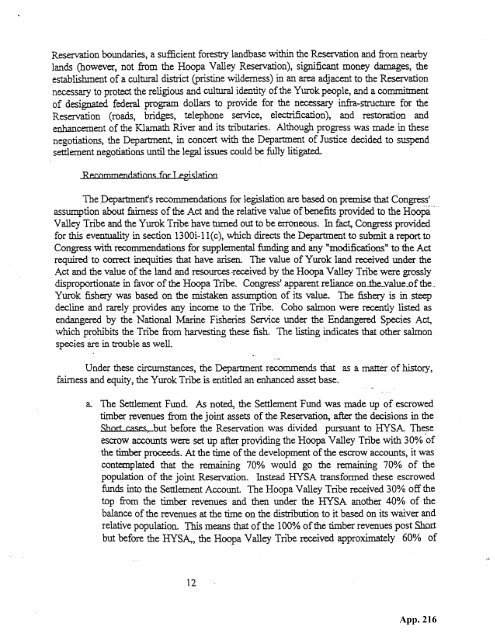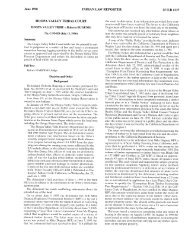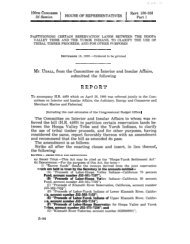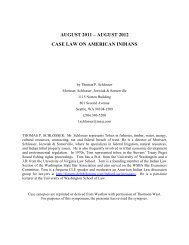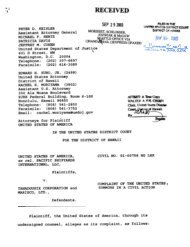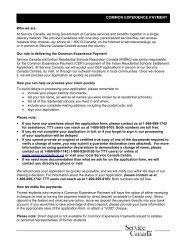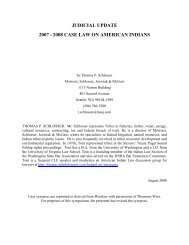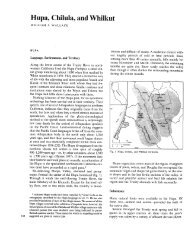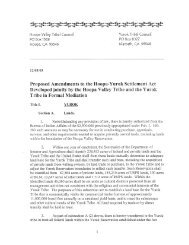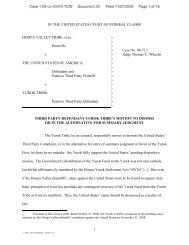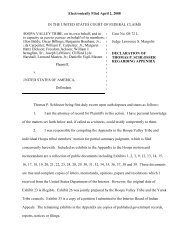Hoopa appendix supporting summary judgment - Schlosser Law Files
Hoopa appendix supporting summary judgment - Schlosser Law Files
Hoopa appendix supporting summary judgment - Schlosser Law Files
Create successful ePaper yourself
Turn your PDF publications into a flip-book with our unique Google optimized e-Paper software.
Reservation boundaries, a sufficient fores~ylandbase within the Reservation and from nearby<br />
lands (however, not from the <strong>Hoopa</strong> Valley Reservation), significant money damages, the<br />
establishment of a cultural district (pristine wilderness) in an area adjacent to the Reservation<br />
necessary to protect the religious and cultural identity ofthe Yurok people, and a commitment<br />
of designated federal program dollars to provide for the necessary infra-structijre for the<br />
Reservation (roads, bridges, telephone service, electrification), and restoration and<br />
enhancement of the Kiamath River and its tributaries. Although progress was made in these<br />
negotiations, the Department, in concert with the Department of Justice decided to suspend<br />
settlement negotiations until the legal issues could be fully litigated.<br />
Rnmmenclation~for I ~ic1ation<br />
The Department’s recommendatiotis for legislation are based on premise that Congress’<br />
assumption about fairness of the Act and the relative value ofbenefits provided to the <strong>Hoopa</strong><br />
Valley Tribe and the Yurok Tribe have turned out to be erroneous. In. fact, Congress provided<br />
for this eventuality in section 1300i-11(c), which directs the Department to submit a report to<br />
Congress with recommendations for supplemental funding and any “modifications” to the Act<br />
required to correct inequities that have arisen. The value of Yurok land received under the<br />
Act and the value ofthe land and resources -received by the <strong>Hoopa</strong> Valley Tribe were grossly<br />
disproportionate in. favor ofthe <strong>Hoopa</strong> Tribe. Congress’ apparentreliance onlhevalueofthe.<br />
Yurok fishery was based on the mistaken assumption of its value. The fishery is in steep<br />
decline and rarely provides any income to the Tribe. Coho salmon were recently listed as<br />
endangered by the National Marine Fisheries Service under the Endangered Species Act,<br />
which prohibits the Tribe from harvesting these fish. The listing indicates that other salmon<br />
species are in. trouble as well.<br />
Under these circumstances, the Department recommends that as a matter of history,<br />
fairness and equity, the Yurok Tribe is entitled an enhanced asset base.<br />
a.. The Settlement Fund. As noted, the Settlement Fund was made up of escrowed<br />
timber revenues from the joint assets ofthe Reservation, after the decisions in the<br />
Short c~ces,but before the Reservation was divided pursuant to HYSA. These<br />
escrow accounts were set up after providing the <strong>Hoopa</strong> Valley Tribe with 30% of<br />
the timber proceeds. At the time ofthe development ofthe escrow accounts, it was<br />
contemplated that the remaining 70% would go the remaining 70% of the<br />
population of the joint Reservation. Instead HYSA transformed these escrowed<br />
funds into the Settlement Account. The <strong>Hoopa</strong> Valley Tribe received 30% off the<br />
top from the timber revenues and then under the HYSA another 40% of the<br />
balance ofthe revenues at the time on the distribution to it based cn its waiver and<br />
relative population. This means that ofthe 100% ofthe timber revenues post Short<br />
but before the HYSA,, the <strong>Hoopa</strong> Valley Tribe received approximately 60% of<br />
12


